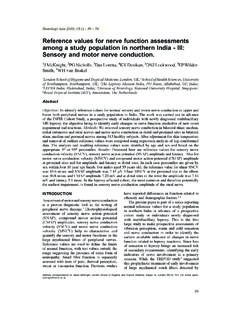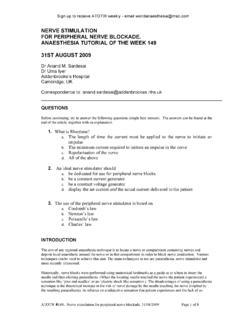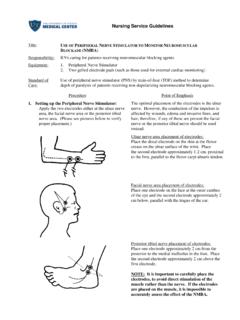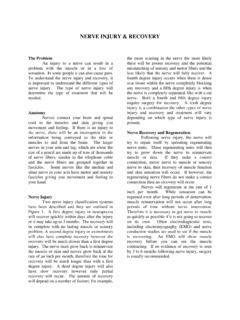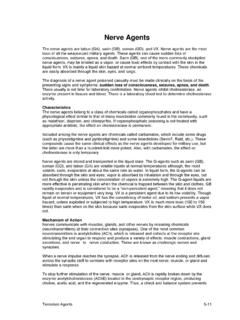Transcription of Diabetes y daño a los nervios - healthinfotranslations.org
1 Diabetes and Nerve Damage. and Nerve DamageDiabetes y da o a los nerviosNerve damage caused by high blood sugar levels in the body from Diabetes is also called diabetic neuropathy. Most people with Diabetes will develop some nerve damage, especially as they get older and have Diabetes for many problems are more common if you have Diabetes and: Have problems controlling your blood sugar Are overweight Have high blood pressure Have high cholesterolTypes of Nerve DamageThere are several types of nerve damage that can occur with Diabetes , but the two more common types are: Peripheral neuropathy that often causes pain or loss of feeling in the toes, feet, legs, hands and arms.
2 Most often the feet and legs are affected before the hands and arms. Autonomic neuropathy that causes changes in digestion of food, bowel and bladder function and sexual response. It can also affect the nerves that control the heart and blood vessels, lungs and eyes. This type is also linked to something called hypoglycemia unawareness, which happens when you no longer have warning signs of low blood sugar da o a los nervios causado por los niveles altos de az car en la sangre por la Diabetes , tambi n se conoce como neuropat a diab tica.
3 La mayor a de las personas con Diabetes sufrir algo de da o a los nervios , especialmente a medida que envejecen y tienen Diabetes por muchos a os. Los problemas a los nervios son m s comunes si tiene Diabetes y: tiene problemas para controlar el az car en la sangre; tiene sobrepeso; tiene la presi n arterial alta; tiene el colesterol de da o a los nerviosHay varios tipos de da o a los nervios que se pueden dar por la Diabetes , pero los dos tipos m s comunes son: Neuropat a perif rica que a menudo causa dolor o p rdida de sensaci n en los dedos de los pies, piernas, manos y brazos.
4 En general los pies y las piernas se ven afectados antes que los brazos y las manos. Neuropat a auton mica que causa cambios en la digesti n de los alimentos, la funci n intestinal y de la vejiga, y la respuesta sexual. Tambi n puede afectar a los nervios que controlan los vasos del coraz n y los sangu neos, los pulmones y los ojos. Este tipo tambi n est vinculado a lo que se llama conciencia sobre la hipoglicemia, que sucedecuando ya no tiene se ales de advertencia de los niveles bajos de az car en la and Nerve Damage.
5 Nerve DamageKeep your blood sugar in a normal range. Work with your doctor and Diabetes care team to learn how to manage your blood sugar part of your care, your doctor should do a foot exam every year to check if you have any sign of loss of feeling in your toes or feet. Daily Foot CareCheck your feet every day for any open skin, sores or red spots. You may have a sore spot and not feel it because of the nerve damage. If you find skin problems, talk to your doctor. Clean your feet each day with warm water and mild soap.
6 Do not soak your feet. Dry your feet well with a soft towel. Be sure to dry between your toes. Check your feet and toes for cuts, scrapes, blisters, red spots, sores or other problems. Be sure to check the top, bottom and sides of your feet. Check under and around each toe. You may need to use a mirror or get someone to help you check the bottom of your feet. Apply a moisturizing lotion to the skin of your feet, but avoid lotion between the toes. Use a pumice stone gently to smooth calluses or corns after a shower. never cut or shave off calluses or corns.
7 When toe nails get long, cut the nails straight across and file with an emery board to smooth any rough edges. Wear clean, dry socks that fit el da o a los nerviosMantenga sus niveles de az car en la sangre dentro de valores saludables. Colabore con su m dico y con su equipo de atenci n de la Diabetes para averiguar c mo mantener controlados sus niveles de az car en la parte de su atenci n, su m dico deber a hacerle un examen de los pies cada a o para comprobar si ha perdido algo de sensibilidad en los dedos de los pies o los diario de los piesRev sese los pies a diario para ver si tiene piel abierta, llagas o manchas rojas.
8 Puede tener una llaga y no notarla por el da o a los nervios . Si detecta problemas en la piel, hable con su m dico. L vese los pies todos los d as con agua tibia y jab n suave. No sumerja sus pies. S quese bien los pies con una toalla suave. Aseg rese de secarse entre los dedos. Compruebe no tener cortes, raspaduras, ampollas, manchas rojas, llagas u otros problemas en los pies y los dedos de los pies. Aseg rese de revisar las partes superior, inferior y los lados de los pies. Mire debajo y alrededor de cada dedo. Tal vez deba usar un espejo o pedirle ayuda a alguien para mirar la parte inferior de los pies.
9 Apl quese loci n hidratante en los pies, pero ev tela entre los dedos. Use una piedra p mez con suavidad para alisar los callos despu s de una ducha. No se los corte nunca. Cuando tenga las u as de los pies largas, c rtelas en l nea recta y l melas con una lima para suavizar los bordes. Use medias limpias y secas que le queden c modas. and Nerve Damage. Spanish. Wear shoes or slippers to protect your feet. You should never go barefoot. Wear shoes that fit well and offer good support. Be sure to check inside your shoes before putting them on to make sure there are no objects in them and there are no tears, rough spots or sharp of Nerve DamageSigns will vary based on the nerves that are affected.
10 Some people have no signs at all. Some signs may get worse over time and some people report the signs are worse at night. Signs may include: Numbness, tingling, loss of feeling or pain in the toes, feet, legs or fingers, hands and arms Muscle loss in the feet or hands Nausea and vomiting or problems with indigestion Diarrhea or constipation Problems with urine flow or control Dizziness or fainting when standing or sitting up that causes a drop in blood pressure called orthostatic hypotension Weakness Erectile dysfunction in men or vaginal dryness in women Heart rate changesIf you have any of these signs, visit your doctor for a physical exam.












